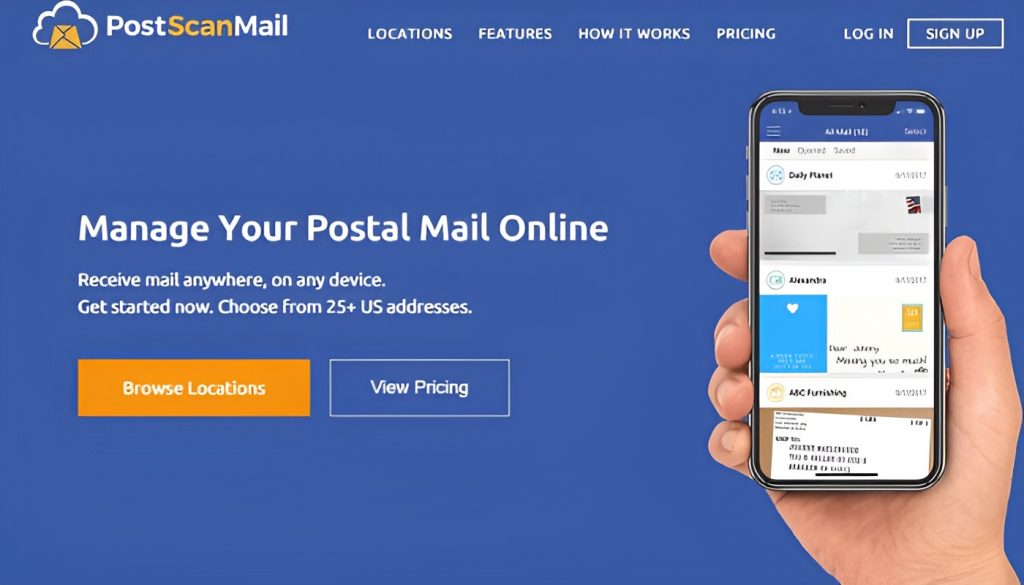Which is Better: A Virtual Mailbox or a Traditional Mailbox?
Imagine this: You’re sitting on a beach in Bali, sipping a cold, fruity drink. The sun is shining, and life is good. A bell chimes in the distance, and you know your mail has arrived even hundreds of miles away from home. What if I told you that this luxurious, carefree lifestyle is now more accessible, all thanks to the advances in digital communications? Gone are the days when you needed to rely solely on a traditional mailbox that held your physical mail.
The world of mail management has evolved, making way for virtual mailboxes! This blog post will look at the fascinating comparison between traditional mailboxes’ old-school charm and virtual mailboxes’ convenience.
Get ready to delve into a world where snail mail meets cutting-edge tech, providing a seamless mail experience for the modern-day globetrotter, entrepreneur, and everyone.
Introduction to virtual mailboxes and traditional mailboxes
A virtual and traditional mailbox is the backbone for receiving and handling postal mail, offering distinct advantages and disadvantages. Understanding how both options work and their benefits are essential to making an informed decision when choosing the best solution for one’s needs.
A traditional mailbox, also known as a physical mailbox, is a container for delivering, collecting, and storing postal mail. It is typically located at the recipient’s address, and the mail is physically handled by the homeowner or a designated person within a company. Traditional mailboxes are notably helpful for receiving packages, providing the simplicity of direct mail delivery to one’s doorstep.
In contrast, a virtual mailbox is a digital service that receives, scans, and stores postal mail and packages on behalf of the user. The process involves using a mailing address at a mail processing center, where each incoming mail item is digitized, allowing users to access their mail through an online account. Virtual mailboxes offer the convenience of accessing postal mail from anywhere with an internet connection, reducing clutter and providing additional security features.
Ultimately, the choice between a virtual and a traditional mailbox largely depends on personal preferences, lifestyle, and specific mail handling requirements. Considering convenience, accessibility, security, and cost can help individuals determine the suitable option for their postal mail management needs.
Virtual mailbox allows 24/7 online access.
Managing correspondence efficiently and securely is paramount for individuals and businesses in today’s digital world. The traditional mailbox, a physical receptacle for receiving mail, has been a go-to option for ages. However, the virtual mailbox, a modern alternative that provides 24/7 online accessibility, offers many advantages over its traditional counterpart. This article compares and contrasts these two options to help you make an informed decision.
1. Accessibility: The most significant difference between the two is the level of convenience they offer. A virtual mailbox allows users 24/7 online access to their postal mail, regardless of location. On the other hand, a traditional mailbox requires a physical visit to collect mail, which can be time-consuming and inconvenient, especially for frequent travelers or individuals with limited mobility.
2. Security: While both options provide a certain level of security, a virtual mailbox has an added advantage as it stores digital copies of mail that can be password-protected. In contrast, physical mailboxes are prone to theft or damage, potentially compromising essential documents and correspondence.
3. Flexibility: A virtual mailbox offers flexible services, such as real-time notifications of mail arrival, mail forwarding, and secure document shredding. On the contrary, a traditional mailbox lacks such features and may require additional services such as PO boxes or mail forwarding at additional costs.
4. Cost-efficiency: Renting a virtual mailbox typically involves a more cost-effective subscription, depending on the provider and services availed. In contrast, traditional mailboxes may require maintenance costs, PO box rental fees, or mail forwarding charges.
In conclusion, a virtual mailbox offers superior accessibility, security, flexibility, and cost-efficiency compared to a traditional mailbox. As the world continues to embrace digital solutions, it’s essential to consider these factors when managing personal or business correspondence.
Traditional mailbox requires a physical presence.
Traditional mailboxes have been the go-to option for mail handling for years, providing a simple approach to receiving letters and parcels. However, the rise of digital technology has paved the way for an innovative mail service known as virtual mailboxes. Here, we present a comparative analysis of the two options, highlighting the key differences and advantages.
- Convenience and Accessibility
A traditional mailbox requires physical presence at your residence or a postal office to access your mail. You may need to travel to your local post office to collect parcels or sift through junk mail, adding to your workload. In contrast, virtual mailboxes offer 24/7 online access, allowing you to view and manage your mail from anywhere with an internet connection. This convenience benefits busy professionals, remote workers, and frequent travelers. - Privacy and Security
A traditional mailbox may expose personal information, such as your residential address, and there’s always the risk of mail theft or damages. On the other hand, virtual mailboxes use secure facilities and encryption to store your mail, providing a higher level of privacy and security. - Mail Filtering and Organization
With a traditional mailbox, sorting and organizing mail can be tedious. Virtual mailboxes solve this problem by scanning and categorizing incoming mail, allowing you to quickly and easily view, forward, shred, or store documents as desired. - Cost Efficiency
Maintaining a traditional mailbox, especially a PO box, may involve added costs such as rental fees and postage for parcel collection. Virtual mailbox services typically have more affordable and flexible pricing plans, ranging from a flat monthly fee to pay-as-you-go options.
In conclusion, virtual mailboxes offer a modern and cost-effective alternative to traditional mailboxes, providing users greater convenience, security, and organization in managing their mail. As technology advances, virtual mailbox services are poised to become an increasingly popular choice for individuals and businesses.
Virtual mailbox requires no setup costs or rental fees.
As more people embrace the digital age and opt for remote work, the concept of virtual mailboxes has gained traction. When compared to traditional mailboxes, virtual mailboxes provide various advantages, especially when it comes to cost-effectiveness. In this article, we will contrast the financial implications of using a virtual mailbox against the costs associated with a traditional mailbox.
Firstly, a virtual mailbox eliminates the need for setup costs or rental fees. Traditional mailboxes, on the other hand, may require an initial investment for installation and ongoing rental or maintenance fees. Virtual mailboxes often charge a monthly subscription fee, which ranges from $10 to $20, depending on the provider and the level of service required. This fee caters to mail scanning, sorting, and storage, making virtual mailboxes more affordable for users seeking convenience and cost savings.
Additionally, virtual mailboxes provide improved accessibility and flexibility. Users can manage their mail 24/7 using an online portal, enabling them to view and forward mail from anywhere with an internet connection. This feature proves invaluable to frequent travelers or those without a permanent address. In contrast, accessing a traditional mailbox requires a physical visit, potentially limiting the user’s ability to react promptly to essential correspondence.
In conclusion, when comparing a virtual mailbox to a traditional mailbox, the former emerges as the more cost-effective and convenient option. Eliminating setup costs, rental fees, and improved accessibility makes it an attractive choice for individuals and businesses seeking to optimize their mail management process without the added financial burden.
Traditional mailbox requires monthly or yearly rental fees.
In today’s fast-paced digital world, the mail delivery concept continues evolving, offering more efficient solutions for businesses and individuals. Virtual and traditional mailboxes are two standard options; however, they differ in several ways, catering to different needs and preferences. This article explores the critical differences between the options based on their functions, costs, and overall convenience.
- Functionality: Virtual mailboxes provide an online platform for users to access and manage their mail anytime, anywhere. On the other hand, traditional mailboxes require physical trips to collect mail and parcels from a designated location.
- Convenience: Virtual mailboxes offer 24/7 access to mail and the ability to scan, forward, or shred items as needed, providing unparalleled flexibility. Conversely, traditional mailboxes typically have limited access hours, resulting in potential mail pickup delays.
- Security: Virtual mailboxes ensure mail privacy, as mail is stored securely online, and users have complete control over mail forwarding. Traditional mailboxes may be prone to theft or tampering, mainly in unsecured public spaces.
- Costs: While both options incur costs, virtual mailboxes typically charge a monthly fee ranging from $10 to $20, with additional fees for extra services. Traditional mailboxes usually involve monthly or yearly rental fees, which can vary in price depending on the location and size.
In conclusion, virtual and traditional mailboxes have unique advantages and drawbacks. While traditional mailboxes may still be suitable for those seeking a simple option for receiving mail, virtual mailboxes stand out as a more advanced, flexible, and safe choice. Ultimately, assessing individual needs, preferences, and budgets is crucial before deciding on the most suitable mailbox solution.
Virtual mailbox provides worldwide access to mail.
A virtual mailbox is an innovative solution that has revolutionized how individuals and businesses manage their postal mail. With the accessibility, security, and convenience it offers, the virtual mailbox has emerged as a far superior alternative to traditional mailboxes. Here are five key reasons why virtual mailboxes outshine their conventional counterparts:
- Worldwide Access: Virtual mailboxes allow users to access their postal mail from any location across the globe. All required is an internet connection and a device to browse the mailbox online. In contrast, traditional mailboxes require physical presence to collect mail, limiting access and flexibility.
- Enhanced Security: Virtual mailboxes provide increased security as they store all mail securely digitally. This helps prevent mail theft, which can be a significant concern with traditional mailboxes that are vulnerable to tampering.
- Professional Business Address: A virtual mailbox gives users a prestigious business address without needing actual office space. This adds credibility and professionalism to their business, something a residential address or a traditional mailbox cannot provide.
- Mail Management and Organization: Virtual mailboxes offer excellent mail management features, allowing users to sort, label, and search their mail with ease. Traditional mailboxes do not offer such organizational capabilities, often leading to clutter and loss of crucial documents.
- Cost-Effective: Renting a virtual mailbox is more cost-effective than maintaining a physical office space or a P.O. box for businesses. Moreover, the convenience of managing mail online saves time, effort, and resources, contributing to overall cost savings.
In conclusion, a virtual mailbox presents many advantages over traditional mailboxes regarding access, security, professionalism, mail management, and cost-efficiency. It caters to the needs of today’s digital, location-independent era, making it the top choice for individuals and businesses.
Traditional mailbox only provides access to one physical location
Businesses and individuals increasingly opt for virtual mailboxes over traditional ones in the digital age. Let’s delve into the key differences between the two and discover which option is best for you.
- Access to mail: Traditional mailboxes only provide access at one physical location, requiring you to visit the premises to check or collect your mail. In contrast, virtual mailboxes offer the convenience of 24/7 online access, enabling you to view, manage, and forward your mail from anywhere with an internet connection.
- Privacy and security: While both options ensure the privacy of your mail, virtual mailboxes provide an added layer of security with mail scanning and digitization, reducing the risk of physical theft or tampering.
- Mail handling: Virtual mailboxes offer additional services such as mail forwarding, shredding, or package receiving, providing a more comprehensive and efficient mail management system than traditional mailboxes.
- Cost: Traditional mailboxes typically have lower upfront costs but may incur additional fees for extra services. Virtual mailboxes have a higher monthly fee but include various added features and benefits.
- Flexibility: A virtual mailbox allows users to manage multiple addresses or mailboxes under one account, facilitating a more organized and streamlined mail solution for businesses with multiple locations or individuals who frequently travel.
In conclusion, while traditional mailboxes have their merits, the benefits of virtual mailboxes far outweigh their drawbacks for most businesses and individuals. With enhanced features, security, and convenience, a virtual mailbox is a practical and modern solution for today’s on-the-go lifestyle.
Virtual mailbox accepts mail from all mailing providers.
As the digital age progresses, virtual mailboxes have emerged as a popular alternative to traditional mailboxes, catering to the needs of remote workers, frequent travelers, and businesses seeking flexibility, privacy, and efficiency. In this article, we’ll compare and contrast the features of virtual and traditional mailboxes, highlighting their key differences.
- Security and Privacy: Virtual mailboxes offer enhanced security and privacy compared to traditional mailboxes since mail is stored securely digitally. On the other hand, traditional mailboxes are vulnerable to theft or damage, primarily if mail is delivered outside the home.
- Accessibility: Virtual mailboxes provide 24/7 online access to your mail from anywhere, as long as you have internet connectivity. Traditional mailboxes, however, require physical access to collect or send mail.
- Package Delivery: Virtual mailboxes accept mail and packages from all mailing providers, giving users a single point to manage their deliveries. Traditional mailboxes may be limited by size or accept only certain types of carriers.
- Mail Management: Virtual mailboxes allow users to view, store, forward, shred, or discard their mail digitally, streamlining the mail management process. With traditional mailboxes, managing mail requires manual sorting and handling.
- Address Flexibility: Virtual mailboxes grant users a physical address without needing a residence or office. Traditional mailboxes are tied to a specific physical location.
- Cost: Virtual mailboxes generally have a lower monthly cost than traditional mailboxes, especially when considering additional services such as mail forwarding and scanning. The costs of owning or renting a physical mailbox can be significantly higher.
- Mail Forwarding: Virtual mailboxes offer flexible mail-forwarding options, including international shipping, allowing users to receive their mail wherever they are. Traditional mailboxes may require additional steps or fees for mail forwarding services.
In conclusion, while virtual and traditional mailboxes have unique benefits, their choice depends on an individual’s or business’s specific needs and preferences. A virtual mailbox can provide enhanced security, accessibility, and flexibility, making it an ideal option for those seeking a modern, versatile mailing solution.
Traditional mailbox only accepts mail from USPS.
Mailboxes serve as essential tools for managing personal and business correspondence. While traditional mailboxes have existed for years, the advent of technology has given rise to virtual mailboxes.
This article will analyze the key differences between traditional and virtual mailboxes to help you make an informed decision.
- Traditional Mailboxes: These are physical lockable boxes rented at local postal offices. They are managed by the United States Postal Service (USPS) and are specifically designed to accept mail from USPS only. Traditional mailboxes come in different sizes and are usually rented monthly or yearly. It is important to note that traditional mailboxes do not accept mail from other mail providers such as FedEx, DHL, and UPS.
- Virtual Mailboxes: A virtual mailbox is an online service that uses an actual street location to receive and manage mail on behalf of clients. The digital nature of a virtual mailbox allows you to access and manage your mail from any device, anytime, and anywhere. Some notable features typically associated with a virtual mailbox include digitization, forwarding services, and other supplementary mail and business management functionalities. Virtual mailboxes come with real street addresses, allowing you to accept mail from all mailing providers, including FedEx, DHL, and UPS.
Conclusion: The choice between a traditional and virtual mailbox depends on your specific needs and preferences. A traditional mailbox may suffice if you require a physical mailbox to accept mail from USPS primarily. However, a virtual mailbox might be the best option if you require a flexible, secure, and convenient mailbox that accepts mail from all providers.
Virtual mailbox digitizes mail for easy access and organization
In today’s fast-paced digital world, efficient mail management is necessary for businesses. Virtual mailboxes and traditional mailboxes are two options available for this purpose. Let’s compare and contrast the two regarding accessibility, organization, and convenience.
A virtual mailbox offers several advantages that set it apart from traditional mailboxes. It digitizes all incoming mail, allowing users to access their mail seamlessly from any device, wherever they are. This feature enables better organization, as users can quickly sort, categorize, and archive their mail online. Moreover, virtual mailboxes provide additional services such as mail forwarding, mail scanning, and secure shredding of unwanted mail.
On the other hand, traditional mailboxes require individuals to physically collect their mail from a designated post office box or a mailroom. This process is time-consuming and offers limited accessibility, as users can only access their mail upon retrieval from the mailbox. Organizing and managing traditional mailboxes can be cumbersome, as it involves dealing with piles of paper and manual sorting.
In conclusion, a virtual mailbox offers a more convenient and efficient solution for mail management, with easy access and organization features catering to the modern business landscape. While still functional, traditional mailboxes may need to provide more convenience and flexibility businesses, require today. Therefore, virtual mailboxes are increasingly becoming the preferred choice for entrepreneurs and established businesses.
Traditional mailbox requires physical retrieval of mail.
In today’s fast-paced, digital world, managing and accessing postal mail is an increasingly important aspect of personal and professional life. As a result, the virtual mailbox has emerged as a popular alternative to the traditional physical mailbox. In this article, we will compare and contrast the advantages and disadvantages of virtual and traditional mailboxes based on factual data.
- Accessibility:
The most significant difference between a virtual and a traditional mailbox is the ease of access. With a virtual mailbox, users can view and manage their mail online 24/7 from any location with an internet connection. This eliminates the need for physical mail retrieval and provides a more convenient option for people who travel frequently or work remotely. On the contrary, a traditional mailbox requires users to visit the location physically to collect their mail. - Privacy and Security:
Virtual mailboxes offer additional privacy and security features, as all incoming mail is sorted, scanned, and securely stored online. Users can also choose to shred or discard mail to protect sensitive information. In contrast, traditional mailboxes present a higher risk of theft, as sensitive mail can be left unattended in the physical box. - Mail Management Options:
A virtual mailbox allows users to customize mail management options such as mail forwarding, scanning, and check deposit services. These options are not available with a traditional mailbox, which often results in time-consuming trips to the post office or bank. - Cost:
Virtual mailboxes typically have a monthly subscription fee ranging from $10 to $20, with additional fees for extra services. Traditional mailboxes may require setup and rental costs, depending on the type and location of the mailbox. - Business Use:
Virtual mailboxes offer several advantages for businesses, including a professional street address, mail acceptance from all delivery providers, and flexibility for changing locations. Traditional mailboxes, especially PO Boxes, may provide a different level of professionalism and can restrict mail delivery options.
In conclusion, while traditional mailboxes have been the norm for many years, virtual mailboxes present a more convenient and efficient alternative in today’s digital age. Individuals and businesses can decide which option best suits their postal needs by considering the unique features and differences.
Summarize the importance
In today’s digital age, a virtual mailbox has emerged as a valuable tool for businesses, entrepreneurs, and individuals, offering numerous advantages over traditional mailboxes. The importance of virtual mailbox services lies in their ability to digitize mail, providing easy access and organization along with 24/7 online availability.
One significant benefit of a virtual mailbox is the convenience of receiving mail, regardless of location. This service eliminates needing to physically visit a traditional mailbox, ensuring that important documents and packages are securely received through an online portal.
Additionally, virtual mailboxes provide enhanced security and privacy, as mail is kept in a centralized, protected location, reducing the risk of tampering or theft.
Another key advantage of virtual mailboxes is the inherent organizational capabilities they offer. Users can quickly sort, label, and store their mail within the online platform, enabling swift retrieval of essential documents when needed. This streamlined organization can save time and reduce clutter, promoting efficiency and productivity.
Finally, the 24/7 online access to mail allows individuals and businesses to manage their mail at their convenience, catering to modern lifestyles and busy schedules.
As a result, virtual mailboxes have become necessary for an increasingly mobile and digital world, providing essential ease of access, security, and organization.
Conclusion and Recommendation
When comparing virtual and traditional mailboxes, it is clear that they offer numerous advantages over their traditional counterparts. Unlike traditional mailbox services, virtual mailboxes like PostScan Mail provide flexibility, convenience, security, and cost-effectiveness.
PostScan Mail is the best virtual mailbox provider for several reasons. To begin with, they have an extensive network with over 600+ locations nationwide and internationally, catering to businesses, startups, busy households, college students, and travelers.
This wide range of locations makes them ideal for anyone seeking a professional business address in various cities.
Furthermore, PostScan Mail offers many valuable features, such as mail scanning, shredding, recycling, mail forwarding, package pickup, and discounted shipping rates. Their secure online platform allows users to manage mail efficiently through a user-friendly interface on multiple devices.
Based on the factual data presented, it is evident that PostScan Mail stands out as the best virtual mailbox provider. We highly recommend PSM to anyone seeking a reliable, secure, and convenient alternative to traditional mailboxes.
You Might Also Like:
- PostScan Mail

- Cyber Monday for Travelers: Stay Connected to Your Deliveries with a Virtual Mailbox

- On the Go: Maximizing Global Adventures with Virtual Mailbox Deals this Black Friday

- Unlock the Power of a Virtual Mailbox with a Real Address

- Pros and Cons of Virtual Mailboxes You Should Evaluate

- Mail Logistics for Rentals: Streamlining the Process





